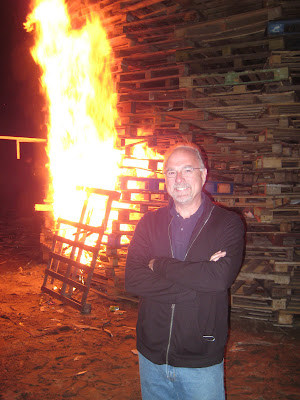






As I mentioned earlier, I visited the Public Records office of Northern Ireland (PRONI). I had information about the marriage of my great-great grandparents, Henry Kerr and Catherine Toman, but the original documents were not there. They were listed as “in local custody.”
I contacted Garvaghy church of Ireland and was put in touch with George Musgrave, church historian. George answered my email and asked me to call him. I emailed back that I’d call; as soon as I arranged transportation to the rural church well off of regular bus routes. “Not to worry,” he wrote back. “Just tell me where you are and I’ll come get you.” I was delighted by his offer—but not surprised. From what I have seen of the Northern Irish, their generosity and kindness, I almost expected him to offer. Helen and I made our way by bus to the nearby town of Dromore where George was waiting at the stop with his car.
George took us out to the 200-year-old Garvaghy Church. He had already gone through the record and made copies, not only of Henry and Catherine’s Marriage registry, but of any record the church had with the name “Kerr” or “Toman.” Still, he opened the safe and removed the old registries so we could look at the actual document. I was able to touch the place where they “signed.” I was surprised to find that my 30-year-old great-great grandfather was apparently unable to read and write. His and Catherine’s signature were in the same handwriting as the man who registered the marriage. Above each “X” in their signatures were the words, “his mark,” and “her mark.”
George showed us around the small church that he said had not changed much in 200 years. The communion rail, added in 1830 would have been in place when Henry was married in 1849. Aside from the carpet, it looks exactly the same. Helen and I posed for a “wedding photo” where Catherine and Henry stood 162 years ago.
Knowing so little about my family beyond Henry’s marriage information, I was interested to see the cemetery. Fortunately, George had done a three-year survey of the cemetery and used his civil engineering skills to create a scale map of each grave. Going back through church records, he identified who was buried in grave whose markers were lost or unreadable.
I cannot be certain that any of the five Kerrs buried in Garvaghy are my ancestors, but I wanted to see if a connection could be made. One of the oldest graves in the cemetery is from a family named “Ker” missing the second “R.” Almost unreadable, the stone is listed in a book titled Gravestone Inscriptions, Vol. 19 published in 1983. It reads, “Sacred to the memory of Thomas and Elizabeth Ker whose remains are interred here and some of their children. Also Robt. Ker of Katesbridge who departed this life April 12, 1806 aged 62 years.”
I can determine for certain that the “Robt.” is not the same “Robert” listed as Henry’s father on the marriage registry. Henry was born in 1819, and this Robert died in 1806. It is possible, however, that “Robt.” could be the Henry’s grandfather. As Henry was illiterate, it would stand to reason his grandfather, Robt., was as well. Unable to spell the family name, it would be left up to someone else—like the man who carved the grave marker— to determine the spelling.
A better possibility is a different grave marker of a James Kerr who died in 1901 at the age of 67. This would have made him born in 1834. Henry also worked a farm with his brother, James, in 1863 according to an old lease.
I was amazing to stand where they stood, to see what they saw.


















